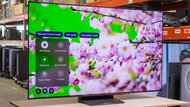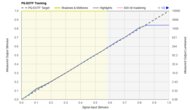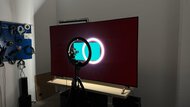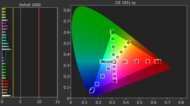120Hz refresh rates have become the norm in the last few years on all mid- to high-end TVs. This faster refresh rate allows you to game at 120 fps. Most TVs on our list pair well with modern consoles, as they support HDMI 2.1 bandwidth for 4k @ 120Hz gaming. Some TVs on this list also support 144Hz and 165Hz, giving you even higher refresh rates if you need that for your PC gaming rig. However, there's more that goes into a good 120Hz model than just its refresh rate, as you still want a TV that provides solid overall picture quality. We perform over 350 tests during our testing process to see just how good a TV is overall. Through this process, we can determine which TVs perform best in terms of contrast, brightness, color, and image processing, and we use this data to inform our model recommendations.
Below are our recommendations for the best TVs you can buy that have at least a 120Hz refresh rate. See our recommendations for the best gaming TVs, the best Nintendo Switch 2 TVs, and the best TV brands. You can also vote on which TVs you want us to buy and test. To learn more about the 2025 TV releases, check out our 2025 TV lineup page.
Quick Look






We buy and test dozens of TVs yearly, taking an objective, data-driven approach to deliver results you can trust. Our testing process is complex, with hundreds of individual tests that take over a week to complete. Most of our tests are done with specially designed test patterns that mimic real content, but we also use the same sources you have at home to ensure our results match the real-world experience. We use two main tools for our testing: a Colorimetry Research CR-100 colorimeter and a CR-250 spectroradiometer.
-
Best 120Hz TV
 Native Refresh Rate165HzCAD In Game Mode @ 120Hz9.74k @ 120Hz5.3 msGaming9.3Game Mode Responsiveness9.4Mixed Usage8.9Home Theater9.0Sports8.8Brightness8.7See all our test resultsColor9.1
Native Refresh Rate165HzCAD In Game Mode @ 120Hz9.74k @ 120Hz5.3 msGaming9.3Game Mode Responsiveness9.4Mixed Usage8.9Home Theater9.0Sports8.8Brightness8.7See all our test resultsColor9.1If you're looking for top-tier performance with minimal drawbacks, the best 120Hz TV we've tested is the Samsung S95F OLED. Thanks to its QD-OLED panel, it delivers exceptionally bright and vivid colors that are sure to impress. Combine that with the TV's perfect black levels and excellent brightness, and you get an incredibly immersive HDR experience whether you're gaming or watching content. Many OLEDs struggle with reflections in bright environments, but the S95F's matte coating and high brightness mean reflections aren't an issue in even the brightest rooms. Its incredibly wide viewing angle makes it a perfect choice for large living rooms with seating off to the sides, since its image quality doesn't degrade. The TV features Samsung's Slim One Connect Box, providing a versatile way to connect your devices and manage cables.
The TV offers a full suite of gaming features, like four HDMI 2.1 ports, VRR, and very low input lag. It supports up to 4k @ 165Hz, so not only can you game in 120Hz, but you can push your frames even higher if you have a powerful gaming PC. You also get the nearly instantaneous pixel transitions OLEDs are known for, so fast motion is crisp.
-
Best Upper Mid-Range 120Hz TV
 Native Refresh Rate144HzCAD In Game Mode @ 120Hz9.84k @ 120Hz5.2 msGaming9.1Game Mode Responsiveness9.4Mixed Usage8.6Home Theater8.8Sports8.1Brightness8.0See all our test resultsColor8.8
Native Refresh Rate144HzCAD In Game Mode @ 120Hz9.84k @ 120Hz5.2 msGaming9.1Game Mode Responsiveness9.4Mixed Usage8.6Home Theater8.8Sports8.1Brightness8.0See all our test resultsColor8.8If you're not interested in the Slim One Connect Box, a 165Hz refresh rate, a matte coating, or if you're simply looking to spend less, consider the Samsung S90F OLED. Like the Samsung S95F OLED, it utilizes a QD-OLED panel in most sizes, allowing you to still enjoy perfect black levels and vivid colors. It also delivers similarly impressive HDR brightness, making gaming or watching content in HDR an impactful and immersive experience. Unfortunately, it doesn't get as bright in SDR, and its reflection handling isn't at the same level as the more expensive Samsung model. However, it still overcomes glare in moderately lit rooms. Nevertheless, you do see reflections on the screen in brighter environments, especially those with direct light sources facing the screen. The TV has the same wide viewing angle as the S95F, which makes it a solid choice for rooms with wide seating arrangements.
Although it doesn't support 165Hz, you can still game in up to 4k @ 144Hz with VRR on any of its four HDMI 2.1 ports. It also features nearly instantaneous pixel transitions and low input lag, so gaming looks clear and feels smooth. You'll want to stick with the 55, 65, and 77-inch models of the TV to ensure you get a QD-OLED panel, and even then, this varies depending on your region.
-
Best Mid-Range 120Hz TV
 Native Refresh Rate120HzCAD In Game Mode @ 120Hz9.64k @ 120Hz5.4 msGaming8.5Game Mode Responsiveness9.0Mixed Usage8.2Home Theater8.4Sports7.1Brightness7.0See all our test resultsColor8.3
Native Refresh Rate120HzCAD In Game Mode @ 120Hz9.64k @ 120Hz5.4 msGaming8.5Game Mode Responsiveness9.0Mixed Usage8.2Home Theater8.4Sports7.1Brightness7.0See all our test resultsColor8.3The best mid-range 120Hz TV we've tested is the LG B5 OLED, which has only a few drawbacks compared to the more expensive OLEDs on this list. Although colors aren't as vivid on this model due to its WOLED panel, they're still quite vibrant and will please most people. It's not as bright in HDR as the QD-OLEDs above, but it's certainly not dim, and highlights still pop out well against its perfect blacks. The TV's just bright enough in SDR to handle glare from overhead lights, but you will want to avoid placing the TV opposite direct light sources, since those are visible on the screen. One advantage this TV has over the Samsung models is that it displays deeper blacks in a bright room, which is particularly beneficial if you regularly watch TV with the lights on.
You won't find a refresh rate above 120Hz on this model, but you still get four HDMI 2.1 ports capable of up to 4k @ 120Hz with VRR, so it's fully compatible with the Xbox Series X|S, PS5, and Switch 2. Like any OLED, motion is crystal clear thanks to its nearly instantaneous pixel transitions. Gaming also feels very responsive thanks to its low input lag, which is great for competitive gamers. Its wide viewing angle makes it a great TV for large living rooms, since anyone sitting off to the sides of the screen sees a similar image as the person sitting centered to it.
-
Best Lower Mid-Range 120Hz TV
 Native Refresh Rate144HzCAD In Game Mode @ 120Hz6.94k @ 120Hz5.8 msGaming7.8Game Mode Responsiveness8.0Mixed Usage7.8Home Theater7.9Sports7.9Brightness7.8See all our test resultsColor7.5
Native Refresh Rate144HzCAD In Game Mode @ 120Hz6.94k @ 120Hz5.8 msGaming7.8Game Mode Responsiveness8.0Mixed Usage7.8Home Theater7.9Sports7.9Brightness7.8See all our test resultsColor7.5If you're a bit tight on money or just don't want an OLED, you can safely step down to the best lower mid-range 120Hz TV we've tested, the TCL QM7K. You don't get the same perfect black levels on the OLEDs listed above, but the TV's very effective local dimming does a fantastic job deepening blacks, making them look bold and impressive. Highlights stand out well in HDR, and colors are vibrant, leading to impressive image quality in HDR movies and games. The TV has great reflection handling and is a very bright model, so bright overhead lights don't cause distracting reflections on the screen. Unfortunately, the TV has a narrow viewing angle, so you need to be sitting directly in front of the screen to enjoy the best possible image quality.
This model supports refresh rates well above 120Hz, which is great for PC gamers. Not only does it offer 4k @ 144Hz, but it also supports 1080p @ 288Hz for those who want to push their frame rate as high as they can. The TV doesn't have the same level of motion handling as the OLED TVs in this article, but they're actually quite good for a Mini LED TV, so fast motion only has some minor blur behind it. It also supports VRR and has low input lag, so you won't find yourself wishing this TV had more gaming features.
-
Best Budget 120Hz TV
 Native Refresh Rate144HzCAD In Game Mode @ 120Hz6.94k @ 120Hz5.5 msGaming7.2Game Mode Responsiveness7.9Mixed Usage7.1Home Theater7.2Sports7.1Brightness6.5See all our test resultsColor7.2
Native Refresh Rate144HzCAD In Game Mode @ 120Hz6.94k @ 120Hz5.5 msGaming7.2Game Mode Responsiveness7.9Mixed Usage7.1Home Theater7.2Sports7.1Brightness6.5See all our test resultsColor7.2If the price of the TCL QM7K is out of reach, you can safely step down to the TCL QM6K without sacrificing very much. Blacks aren't as deep as they are on the QM7K, but the TV still has an awesome local dimming feature, so blacks look bold. Colors are still vibrant enough to enjoy, but they aren't as punchy and bright as they are on the QM7K. Fortunately, the TV has the SDR brightness needed to handle glare in well-lit rooms. However, this model barely lessens the intensity of direct reflections, so avoid placing it opposite a window or lamp. The TV is noticeably dimmer in HDR than the QM7K, so even though it still provides a decent HDR experience, it's a bit underwhelming compared to the other options on this list. Its viewing angle is almost as wide as the QM7K, making it a suitable choice if you have a couple of friends sitting at a slight angle from the screen. However, it's not ideal for wide seating arrangements.
Even though its image quality isn't quite as good as the QM7K, it still offers most of the same gaming features. You can game in either 4k @ 144Hz or 1080p @ 288Hz, pixel transitions are almost as fast, input lag is low, and it supports VRR. This TV features the necessary capabilities to take full advantage of modern consoles, and it also makes a solid pairing with your gaming PC.
Notable Mentions
-
LG G5 OLED:
The LG G5 OLED is a solid alternative to the Samsung S95F OLED. It has very impressive colors, but it still doesn't match the level of vividness you get from a QD-OLED TV like the Samsung. Furthermore, the LG doesn't do as good of a job reducing the intensity of reflections, making the Samsung the more versatile gaming TV.
See our review -
LG C5 OLED:
The LG C5 OLED is an alternative to the Samsung S90F OLED. It's brighter than the Samsung in SDR, displays deeper blacks in a bright room, and offer Dolby Vision. However, the Samsung is brighter in its dedicated gaming mode and displays more vivid colors, making it a better option for most gamers.
See our review -
Samsung S85F OLED:
The Samsung S85F OLED is a solid alternative to the LG B5 OLED, but only if you're looking for a 55 or 65-inch model in the US. Like its more expensive older siblings, the Samsung model utilizes a QD-OLED panel, which displays more vibrant colors. However, the LG is a better choice for most people since it's the brighter TV overall, more accurate, and you know what you're getting from it, regardless of the size you purchase.
See our review -
Hisense U75QG:
The Hisense U75QG is a good option if you want something brighter than the TCL QM7K. However, the Hisense has slow pixel transitions, so fast motion is quite blurry. The Hisense also drastically overbrightens HDR content. Since the TCL has much clearer motion and superior contrast, it's the better TV all around.
See our review -
Hisense U65QF:
The Hisense U65QF is comparable to the TCL QM6K but is noticeably brighter. However, the Hisense displays HDR content much brighter than intended. The Hisense also doesn't support 1440p @ 120Hz, which limits its usefulness for Switch 2 owners. Since the TCL supports 1440p @ 120Hz, has better black levels, and has superior overall accuracy, it's the better choice for most people.
See our review
Recent Updates
Nov 11, 2025:
Replaced the LG B4 OLED with the LG B5 OLED in the 'Best Mid-Range' category.
Jul 16, 2025:
We replaced the Samsung S90D OLED with the Samsung S95F OLED as our new top pick. We also replaced the LG C4 OLED with the Samsung S90F OLED in the 'Upper Mid-Range' category, the Hisense U7N with the TCL QM7K in the 'Lower Mid-Range' category, and the TCL Q651G with the TCL QM6K in the 'Budget' category. We also dropped the 'Best Bright Room' category, since the S95F outperforms our old pick, the Sony BRAVIA 9.
Apr 16, 2025:
Refreshed some text throughout the article for clarity. We also removed the TCL QM7/QM751G QLED and the Hisense U6/U6N from the Notable Mentions section and added mention of the TVs in their comparable picks instead.
Dec 09, 2024:
Refreshed some text in the introduction for clarity and accuracy.
Sep 19, 2024: Replaced the Samsung S90C OLED, LG C3 OLED, LG B3 OLED, and TCL Q5/Q550G QLED with their 2024 successors and updated the Notable Mentions.
All Reviews
Our recommendations are based on what we think are the best 120Hz TVs currently available. They are adapted to be valid for most people in each price range. The rating is based on our review, factoring in price and feedback from our visitors.
If you would prefer the make your own decision, here is the list of all of our TV reviews. Be careful not to get too caught up in the details. Most TVs are good enough to please most people, and the things we fault TVs on are often not noticeable unless you really look for them. Also, keep in mind that our scores aren't comparable across different test benches, so the older TVs in the list below score higher than they would today.















